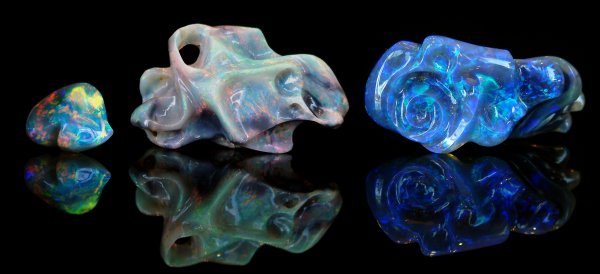
The beautiful optical properties of the gemstone opal are the result of tiny amounts of uranium present when the stones were formed, say researchers in Australia. They claim that their work could lead to the production of artificial opal and have already shown that the gamma rays given off by the uranium and its radioactive daughters can lead geologists to new underground deposits of the gem.
Opal is made of amorphous silica and this makes it very difficult to find because the gem is usually surrounded by other rocks made of the same material. “Precious” opal differs from the much less valuable common opal in that it contains spheres of silica about 200 nm in diameter that are arranged in a regular superlattice. This gives the gem its famous “play of colour” — different colours that appear when opal is viewed from different angles — which is caused by the diffraction of light in the superlattice.
Now, geologist Brian Senior and physicist Lewis Chadderton have discovered that the superlattice of spheres forms because of the presence of tiny quantities of uranium and its decay products. Using analytical techniques such as electron microscopy and neutron activation analysis along with theoretical models of sedimentation processes, the team have shown that some of the very heavy elements that are made when uranium decays act as a “seeds” for the formation of the silica spheres during sedimentation.
Gamma-ray logging
The uranium also makes precious opal much more radioactive than surrounding silica-based rocks, which tend to have low levels of radioactivity. With this in mind, Senior and Chadderton have adapted a standard tool of oil exploration called gamma-ray logging to create a technique for finding precious opal.
Their technique involves boring a minimum of three holes in a region where the gem is thought to occur. A sodium iodide gamma ray detector is lowered by a winch into each hole and readings are taken every 15 cm. Data are collected on a laptop computer and the system is installed in the back of a four-wheel drive vehicle. If high levels of gamma rays are detected, the data from the three bores are triangulated to locate the centre of the deposit.
The team have used their technique to find new deposits at several locations in Australia. Senior, who runs his own consulting company, believes that the technique could be a boon to Australia’s opal mining industry — which, despite producing over 90% of the world’s precious opal, he describes as a “cottage industry”.
Chadderton, who is at the Australian National University in Canberra, told physicsworld.com that the team are using their insight into opal formation to create artificial gems. As well as being used in jewellery, Chadderton believe that such opals could be engineered to be photonic crystals. These materials can be used to control light in much the same way as semiconductors are used to control electrical currents — something that could make them very useful in fibre-optical communications systems. Senior and Chadderton will report their results in an upcoming issue of The Australian Gemmologist .



